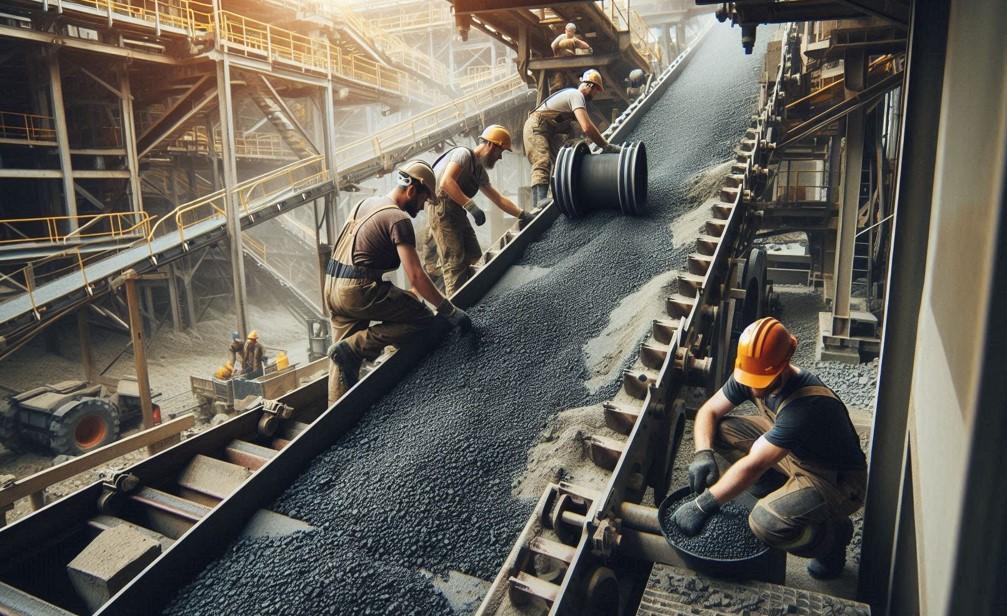Conveyor systems are the cornerstone of material handling processes in various industries, from mining and quarrying to manufacturing and logistics. They facilitate the efficient movement of bulk materials; however, they can also lead to material wastage and dust accumulation. Conveyor skirting systems are designed to help contain materials, prevent spillage, and maintain a cleaner and safer work environment.
In this blog, we delve deeper into the role of conveyor skirting in material handling processes and understand how these systems can benefit the Australian mining industry.
What is Conveyor Skirting?
Conveyor skirting is a protective system installed along the sides of a conveyor belt at loading and transfer points. It typically consists of flexible sealing strips that press against the belt’s surface, creating a barrier to keep materials from escaping.
This containment system is crucial in material handling as it prevents spillage, reduces dust emissions, and minimises product loss. By containing the material on the belt, conveyor skirting not only enhances the efficiency of the mining conveyor belt but also contributes to a cleaner and safer working environment.
Components of Conveyor Skirting
A typical conveyor skirting system consists of the following components:
- Skirt Boards: These are the rigid panels attached to the sides of the conveyor structure, providing a mounting surface for the skirting material.
- Skirting Material: This flexible sealing element comes into contact with the conveyor belt, preventing material spillage. Depending on the application, it can be made from various materials such as rubber, polyurethane, or composite blends.
- Clamp Systems: These are used to secure the skirting material to the skirt boards, allowing for easy adjustment and replacement.
Types of Conveyor Skirting
Conveyor skirting systems can be classified based on their material composition and design. The most common types include:
- Rubber Skirting: This is the traditional and most widely used type. It is cost-effective and provides good sealing properties for most bulk materials.
- Polyurethane Skirting: Known for its durability and resistance to wear and tear, polyurethane skirting is ideal for applications involving abrasive materials.
- Composite Skirting: A blend of different materials, composite skirting offers a balance of flexibility, durability, and chemical resistance.
Benefits of Proper Conveyor Skirting Installation
Controls Dust and Debris
Properly installed conveyor skirting plays a critical role in controlling dust and debris generated during material handling. By sealing the conveyor belt edges, skirting prevents fine particles from becoming airborne, improving air quality and reducing the need for additional dust suppression systems. This is particularly important in the Australian mining industry, where dust can pose health risks and environmental challenges.
Improves Material Containment
Conveyor skirting ensures that materials stay on the conveyor belt, minimising spillage and loss. This containment not only prevents valuable materials from being wasted but also helps maintain a consistent flow of materials through the production process. Improved containment reduces the need for manual intervention and cleaning, thereby enhancing operational efficiency.
Reduces Conveyor Belt Damage
By preventing materials from spilling over and accumulating around the conveyor system, skirting reduces the wear and tear on conveyor belts and other components. This helps with corrosion prevention and extends the lifespan of the equipment. Proper skirting also helps in maintaining the alignment of the belt, reducing the risk of mechanical failures.
Minimises Spillage and Wastage
Spillage can lead to significant material loss and increased operational costs. Proper skirting minimises this issue by creating a tight seal that keeps materials confined to the conveyor belt. This reduction in spillage not only conserves resources but also decreases the frequency of cleanups, leading to a more streamlined and cost-effective operation.
Lowers Cleanup Costs
The containment of materials and control of dust and debris significantly reduces the need for regular cleanups around the conveyor system. This leads to lower labour costs and less downtime for maintenance activities. Additionally, a cleaner work environment reduces the risk of equipment damage and operational interruptions, contributing to overall cost savings.
Increases Productivity
With less spillage and reduced downtime for maintenance, mining conveyor belts can operate more efficiently and continuously. This increase in operational uptime directly translates to higher productivity levels. By ensuring that materials are consistently contained and transported, skirting helps maintain a steady production flow, essential for meeting production targets.
Enhances Workplace Safety
Proper conveyor skirting enhances workplace safety by minimising the risks associated with material spillage and dust. Spilled materials can create slip hazards, while dust can affect air quality and pose respiratory risks. By containing these elements, skirting reduces the likelihood of accidents and health issues, fostering a safer work environment for employees.
Conclusion
Conveyor skirting is an integral part of the material handling process, offering numerous benefits that enhance efficiency, safety, and productivity. Ensuring proper installation and maintenance of these systems leads to reduced operational costs, improved product containment, and a safer workplace.
Australian Mining Product and Services offers a wide range of mining equipment and products, such as screen media, conveyor idler rollers, and more. Call 1300 241 620 to request a quote from us, call at 1300 241 620.

